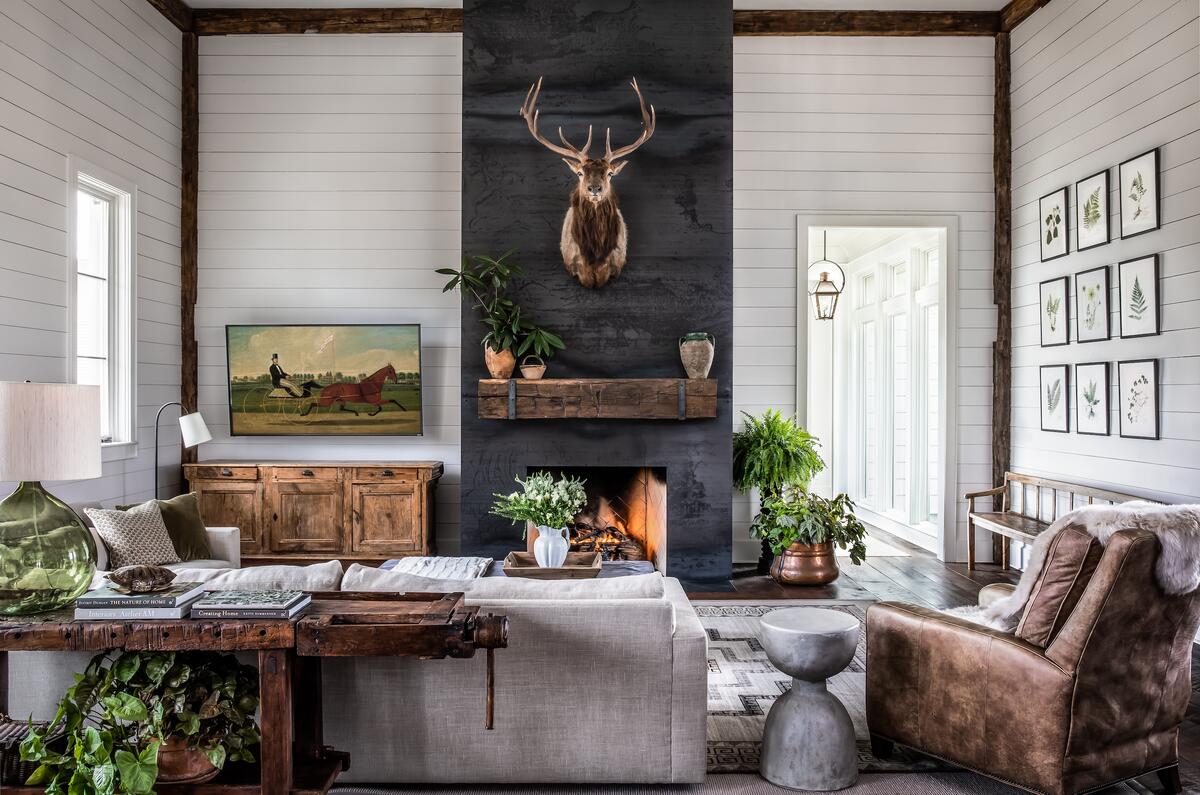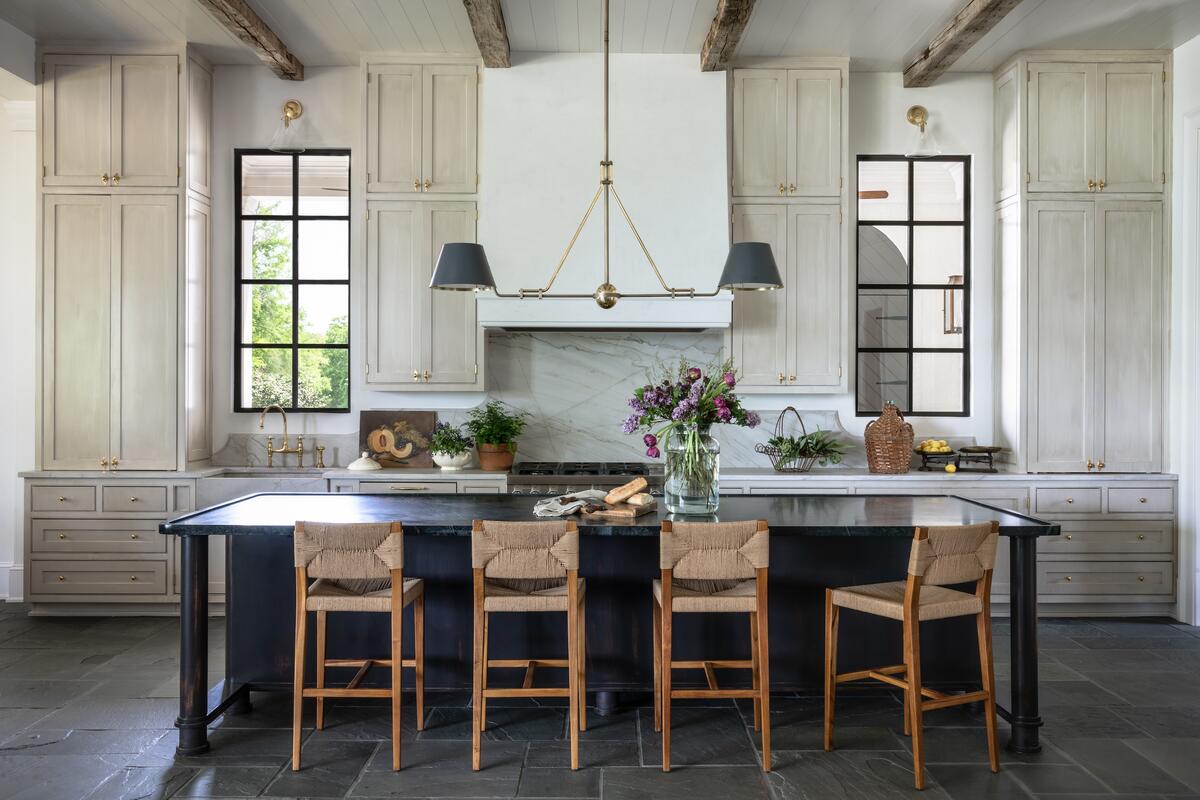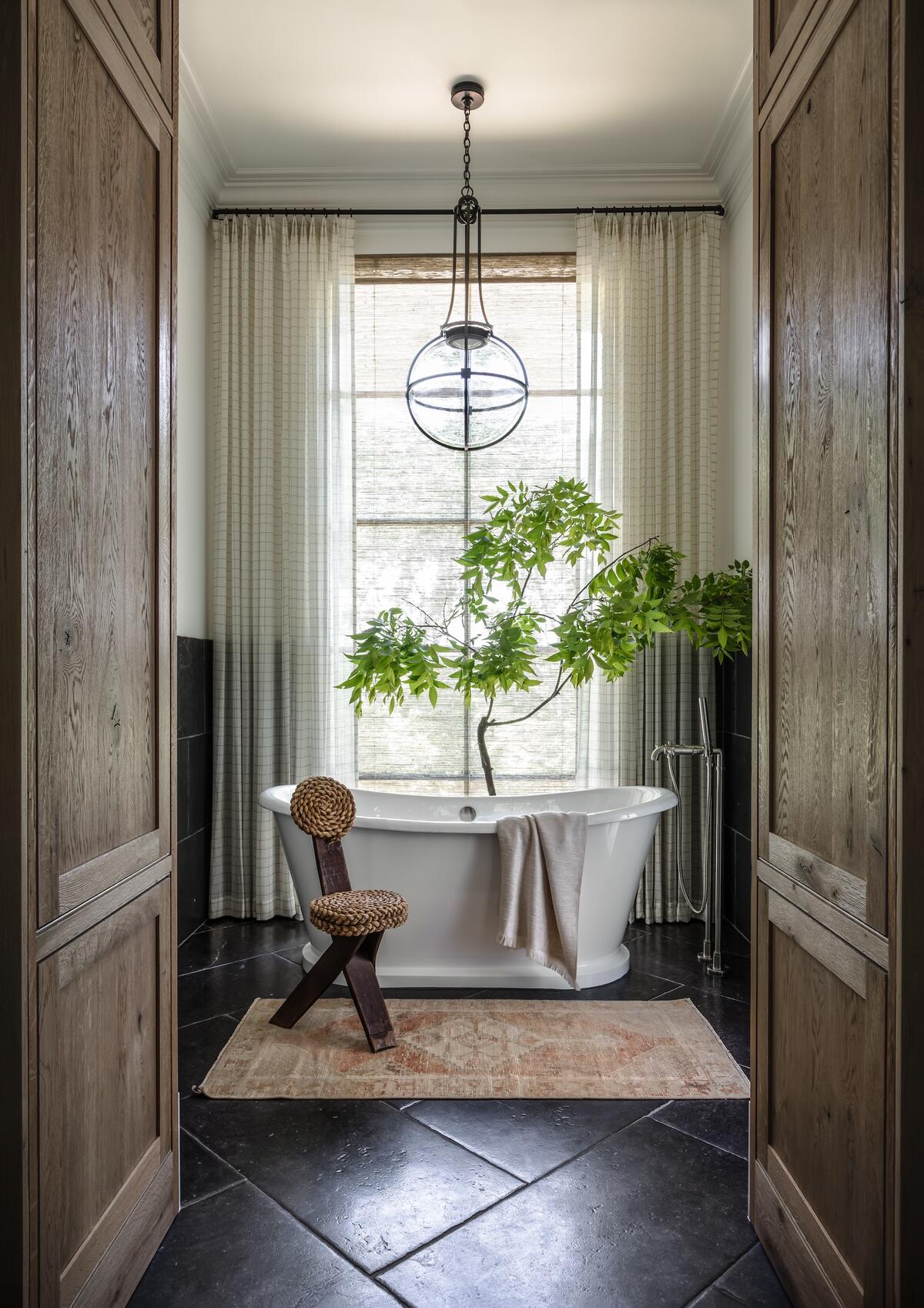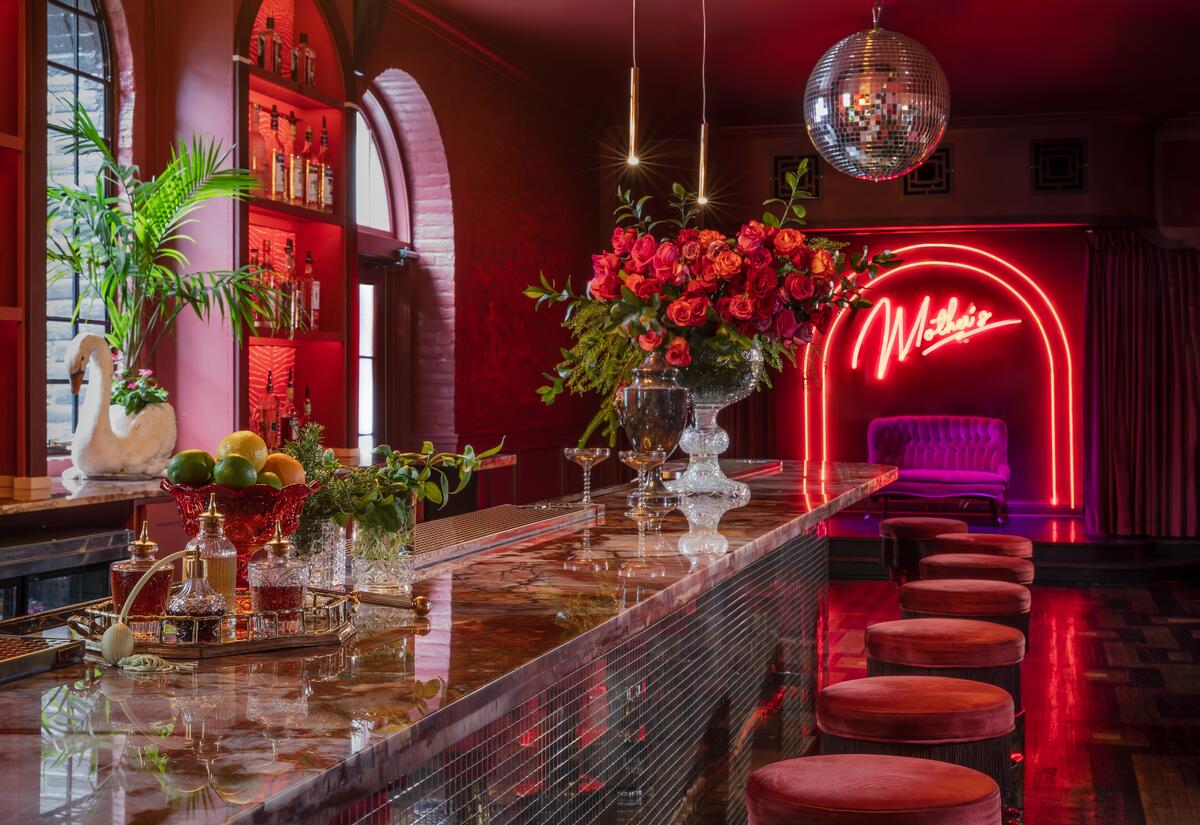The 50 States Project is a series of candid conversations with interior designers across the country about how they’ve built their businesses. This week, Baton Rouge, Louisiana–based mother-daughter designers Cindy and Bridget Tiek and architect Hance Day Hughes of Tiek Byday tell us about bringing design into the earliest stages of the architecture process, how the firm emerged stronger and leaner after a tough year, and why they’re expanding to one promising Texas market.
How did the three of you come to be business partners?
Cindy Tiek: It was a long time coming. We started our own businesses at roughly the same time, in 2016 and 2017. Hance had his architecture firm, and Bridget and I had Tiek & Co., our interior design firm. We had known each other [since their] childhood, but Hance approached Bridget and me for two projects: an office space and then his parents’ home.
Hance Day Hughes: Our first project together was Gatorworks, which was a full office space. The girls always give me a hard time and laugh, because I came in very architecturally minded. I was thinking very basic thoughts: “This is all going to be white.” And it was not in any way in line with what the client was asking for, or what Bridget and Cindy thought they really needed.
Bridget Tiek: He was like, “You just need to go pick some paint colors. It’s just going to be clean and modern and white.” But if you look at the project on our website—
That’s not what these pictures look like.
Bridget Tiek: Right. The client had a different thought. Over the next few years, we were doing more and more work together. At some point, 75 percent of the work was together, but we had two different studio managers, we were running payroll two times—we were doing everything twice. We bought a building together. And at some point, it was like, “I think we’re committed. I think it’s time.”
What makes your partnership work?
Hance Day Hughes: Trust.
Cindy Tiek: I agree.
Bridget Tiek: And we all have the same level of passion and integrity for the outcome of the project. There’s never this sense of, “Let’s just do it to make our money and get out of here.” Yes, it is a business, but we are all so passionate. You can tell the difference when you work with somebody who is not truly passionate about this.
Hance Day Hughes: As we were working with other interior designers or architects, we were getting frustrated by what we found lacking in the other professional, and that the project was not getting to the level it deserved. We knew that together, we could control that—that we could get it there.
Bridget Tiek: The traditional idea is that the architect does their job, and then the project gets handed to an interior designer after so many things have been finalized—but we realized that is the worst way to do it. That’s why it was so problematic when we were working with an outside team. If we were brought on to a job with another architect, it always felt like they were going to do their part, then hand it off to us to just pick some finishes, and we would have no input on space planning, or things like where the HVAC vent was placed. But I don’t want to see that HVAC vent, you know? We think through all those things, and it works better if it’s hand in hand.
Cindy Tiek: We don’t really distinguish between the roles as much as most firms. I think the biggest place where we differentiate is in procurement—that is strictly the interior designers. But when it comes to architecture, exterior architecture and millwork details, all of that is truly a collaboration.

What changed about the way you worked as you merged?
Hance Day Hughes: Last year was one of the hardest years ever. We’re both seven years in, and we merged two businesses and had to figure out how to stay afloat. Bridget and Cindy were always a partnership, and they had divided up some of their hats; I only had a business partner for a year, so [I arrived] wearing more hats.
We’re a top-heavy company right now—we have seven full-time employees and two rotational employees—and how our roles need to shift to make our business successful is something that we’ve truly only begun to figure out over the last four months.
Bridget Tiek: When we merged the companies, we had more employees than we needed—two studio managers and extra design staff. That was a big challenge. And we really started to home in on the idea that we only wanted to do joint projects: clients who wanted the full scope of architecture and interior design. So, suddenly we’re turning away work. We had the same number of employees, but we weren’t taking on the smaller jobs that we had before. Yes, up to 70 percent of our projects merged, but that extra 30 percent [of work at both firms is what had] paid our workforce. It was a hard adjustment to make.
Hance Day Hughes: When you looked at the two P&Ls, the companies were both successful. But as we began to demand certain things of our projects, we were also starting to see that [post-pandemic] recession.
Cindy Tiek: And that was on top of committing to building the new brand. It was a tough year.
Bridget Tiek: We got lost in the sauce there for a second. We needed to do marketing, so we were committed to a heavy photography budget, because we did not have a lot of new work to show. But that costs a lot of money. We were building a website, paying for branding, all that stuff—and that’s when we conceived the idea that we were adding a showroom. You realize, “Oh, shit, we’ve got too much going.”

Are you feeling like you’re in a better place now?
Bridget Tiek: It’s definitely way better. We downsized to a smaller team, and we now have a tight-knit group that works so well together. Projects started picking back up—and all those things that we were investing in, like photography and marketing, started to pay off. The phone started to ring, and all the new work started coming. But at the same time, we’re still on our growth journey, because we are redesigning our own office and showroom right now—all of that is still under construction—and we’re trying to expand our market into Fort Worth, as well.
Hance Day Hughes: We just had our company retreat, and it was a good reflection of what we’ve done so far this year. Right now, we’re able to pump out two to three larger projects that get photographed each year. The team just photographed one of those this week, and then we’ve got what I’d call our best commercial job—and certainly our largest restaurant in the local market, with the biggest reach in terms of clientele—which opens tonight.
Congratulations!
Hance Day Hughes: Thank you. And then our best residential project—it’s a very interesting one that has pushed our boundaries—will be photographed this summer. It’s in the Fort Worth market, and we’ve been working on it as a group for three-plus years. I feel like the best is yet to come in terms of the work that we’re getting to share with the world and where that leads our company.
What did you want to accomplish at that company retreat?
Bridget Tiek: We try to do it in the first quarter of every year so we can talk about goals. There’s always a big team goal, and then everyone has their individual goals. It looked a lot different last year because we had just merged—it was a lot about making everyone feel good that this is now one big company. This year, it feels like everyone is pretty cemented in being a team.
Hance Day Hughes: We share where we were last year on the financial side. As principals, we have already gotten together to discuss raises and bonuses internally, so we also meet with each employee. And then a big part of it is just bonding with the team—getting away from the workplace and eating and drinking and hanging out together.
What does the firm look like today?
Cindy Tiek: There are seven of us full-time. Bridget, Hance and I all have multifunctional roles within the company—we have realized our strengths and where we want to be. Bridget does the PR and marketing; Hance and I are sharing financial responsibilities. He is also more on the business development side, and dealing with the ins and outs of the procurement side of the business. Bridget and I split up clients on the interior side. And then the three of us are also the faces of the company, so we go on initial site visits and all the initial meetings with clients, then get the proposals out to them.
Our studio manager handles all of the day-to-day operational functions: billing, accounting, bookkeeping, keeping the project schedules overall for everyone. And then we have a remote designer on the interior side who is our procurement manager; and two architects who do most of the drawings and handle construction administration.
Hance Day Hughes: We also have an internship program with two students at a time—a little program that they go through to help us do odds and ends.
Does this feel like the team formation where you’re happy and where you want to be?
Hance Day Hughes: Yes. Letting people go was probably one of the hardest things I’ve ever done—I absolutely hated it—but I’ve come to learn that it’s sometimes the best thing that can happen to the company. Right now, everybody’s on the same level. We’re very hesitant to add somebody to the team, regardless of the workload, because we want to make sure that we grow smart moving forward, and they have to share the same values that the company does.


How does the local market impact the way you work?
Bridget Tiek: We talk all the time about how many people are willing to dive into what their true personal aesthetic is versus keeping up with the Joneses—because that’s what a large part of our market is doing. They’re designing something that feels safe and comfortable because their neighbor has it and it looks good enough.
Cindy Tiek: Baton Rouge is a city, but it’s primarily a college town. Louisiana is an oil-based state. And so when you think about the workforce here—people tend to grow up here and they don’t leave. There’s very little exposure to design or what to expect from a designer, which can be limiting sometimes. It’s a hard road when you’re dealing with someone who doesn’t know anything about the process or what makes something good or bad, or [doesn’t understand] their own taste.
Or how much it should cost?
Bridget Tiek: That’s a huge one. They have no idea. You can say to someone, “You went into that showroom and saw that the sofa was $10,000,” and they’re like, “Yeah, no big deal.” Then you’re like, “And you know that [other] sofa could be $20,000,” and they’re still like, “Yeah, OK.” But when they see it all together, the cost of redoing their entire home still comes as a very big sticker shock.
Hance Day Hughes: In the architecture world, another struggle is that we used to be your go-to person [when you wanted to build a home]. I don’t know when this stopped, but builders in the residential market [have presented themselves] as the one-stop shop, and then they hire out the architecture. That means that in our market, a lot of people are licensed architects but they essentially practice as draftsmen—and I’m not saying that in a negative way. It’s just the product that they’re providing is lean, and it’s very, very affordable. Now, is it affordable in the lifecycle costs to a client? We argue no. But an upfront drawing cost? Yes, absolutely.
So, here we are with our very detailed plan sets and detailed processes to get from a concept to reality through construction—that takes a lot of time and investment. Following the old-school models of design, 10 to 12 percent [of the project budget] for design is where we fall, but that’s just absurd for a lot of people here who are building a $2 million property. Having to navigate that has been very challenging, because there just doesn’t seem to be many people practicing on the architecture front in our town. It’s kind of going away.
Then on the interior design side, which I’ve learned a lot about in the last year, it’s a whole different business, because you’re selling products instead of services only. Where’s the money in furniture? Where is it in services? How do you mark up the product? Do you give a percentage off retail? [The variety of ways to charge] is just insane.
Bridget Tiek: There is no standard, so it’s hard for clients to compare. We’ve had people who were shopping for designers tell me, “Well, this person told me it works like this.” And I’m like, “OK, what are you getting for that?” And they’re like, “I don’t know. Interior design?” That’s a loaded statement.
That could mean so many different things.
Bridget Tiek: There are so many levels of service, and then the way it’s all priced makes it even more confusing.
Hance Day Hughes: When we decided to open the showroom, we were thinking a lot about how to diversify our income. And one of the thoughts we had was that, if we truly are getting stocking-dealer [pricing] on some of the accounts because of our brick-and-mortar showroom, would other designers be interested in purchasing through us? What is the value that Tiek Byday could provide?

Where did you land when you were thinking about how you charge for the work?
Hance Day Hughes: It changes monthly.
Cindy Tiek: All the time. We learn, and we’re like, “Nope, we’re doing it this way next time.” We started out with hourly, and we hated that. Then we moved to a fee for a scope of work, which we still do to some extent for smaller jobs where we can readily define a scope. On a big project, we charge more like architects, where we do a percent of the total value of construction, plus furnishings for the job.
Hance Day Hughes: And then for clients who are spending X amount of dollars doing full-service projects, they get a percentage off of retail for the cost of their goods. That cost ranges based on where that good is coming from—it’s different if it’s something that we have stocking dealer on, which we call a Tiek Byday brand, or if it’s something we’re buying from a direct-to-consumer brand, or if it’s an antique or a one-off. There are nuances to how that works on the procurement side, but that’s the gist of it.
Does that make sense to clients? Is that easy to explain?
Bridget Tiek: Yes. We used to do cost-plus, and all they heard was that they were paying more—even though it was actually less [than retail]. People would rather hear that they’re getting a discount. But that honestly is just a sales approach. Now they see what full price was, and then they see a discounted number and they say, “Yay.” It’s a mental thing.
Hance Day Hughes: But there’s still a strategy [required] to stay competitive. You need stocking-dealer pricing to be able to offer that on certain things.
So was stocking-dealer pricing a big driver in opening the showroom?
Hance Day Hughes: Yes, for sure.
Bridget Tiek: It’s also a way to host clients somewhere that we’ve designed—that spoke to our aesthetic. It gives us the opportunity to sell to outside people, diversifying a revenue stream.
Hance Day Hughes: A big, big part of the showroom is creating an environment that we can be happy in, and that we want our team to be happy in. As designers, all you do is look at the space around you. We want to be at equilibrium so we can work. The goal is to be in a space that we enjoy to operate in every day and feel proud to bring people into.
You mentioned growing your business in Fort Worth—which isn’t exactly nearby. Why is that the target?
Bridget Tiek: We have a client there now, and they’re just such wonderful clients. It’s one of the fastest-growing cities in the U.S., so the opportunity is there. It’s not like people are flooding into Baton Rouge, I can tell you that.
Hance Day Hughes: Our client lives in a fantastic neighborhood. And even the passing conversations we’ve had with this network of people have been very eye-opening to us, and very exciting to us, because people are seeing value in the things that we see value in.
Bridget Tiek: It is also easy for us to get there. All three of us live in the same neighborhood, 20 minutes from the airport, and it’s an hour-and-a-half flight. We have flown there and back in the same day.
Hance Day Hughes: We were going in two- to four-week intervals, depending on where we are in construction. During the design process, there wasn’t the need to be there so much.

What is the biggest challenge you see up ahead for the firm and the industry at large?
Bridget Tiek: I think our biggest challenge will be when we open the showroom, and what kind of foot traffic it engages, and what kind of change that will be for us. I think there’s a big question mark there on what that’s going to bring, and if we’re ready for that.
Cindy Tiek: And in the short-term is the actual fact that we’re living through construction. We’re doing our own design-build and living through it. That’s been challenging lately.
Hance Day Hughes: One of the challenges I see is still being able to pivot enough to keep doing the work that we want to do. Because if we’re not doing what we love, we can go work for somebody else. We also realize that to get where we need to go, it won’t be through work only in Baton Rouge [and Fort Worth]. How do we become national designers? At our retreat, one of our goals was to become an AD100 firm. There’s never been one from Louisiana, and it’s like, “How do we get there?”
That’s amazing. Maybe that’s the answer, but I’ll ask anyway: What does success look like to each of you?
Bridget Tiek: Being able to create projects that we’re proud of, and where people are nice to us while we’re doing it. That is enough. Sometimes you can have these glorious projects, but there’s turmoil the whole time—even when you get this beautiful outcome, it just doesn’t feel like success.
Cindy Tiek: I have been on this Earth a little bit longer than Bridget and Hance. For me, it is about coming up with excellent projects, and being proud of what we do and put out in the world. I love seeing people fulfilled and happy with their results. When a client comes back and says, “I just absolutely love this,” that is so meaningful that we’ve impacted their life.
Hance Day Hughes: Prior to retreat, the three of us were meeting about redefining our purpose. And one of the things that resonates with me personally is that we aim to guide our clients toward realizing dreams that they may not have known they had. There’s nothing better than that.
Bridget Tiek: That is definitely it. People come back and tell us, “You made me think of things differently, and I didn’t know that I could live that way.” You’re asking them questions that ultimately allow them to enjoy their life that much more—and once you’ve had that happen, you always want it to happen.
To learn more about Tiek Byday, visit the firm’s website or find them on Instagram.





























